Kangaroo
Females have a deep pouch on their front!
Advertisement
Kangaroo Scientific Classification
Read our Complete Guide to Classification of Animals.
Kangaroo Conservation Status
Kangaroo Facts
- Average Litter Size
- 2
- Lifestyle
- Sociable
- Favorite Food
- Grass
- Type
- Mammal
- Slogan
- Females have a deep pouch on their front!
View all of the Kangaroo images!
The kangaroo is among the most remarkable leapers of the animal kingdom. They are also bipedal, meaning they walk on two legs.
When it’s in motion, the kangaroo hops completely clear off the ground, covering up to 30 feet in a single swift motion. No other large animal of this size has the same ability. As the national symbol of Australia, the kangaroo adorns a coat of arms, coins, and even the logos of sports teams and organizations. It has adapted very well to the presence of humans.
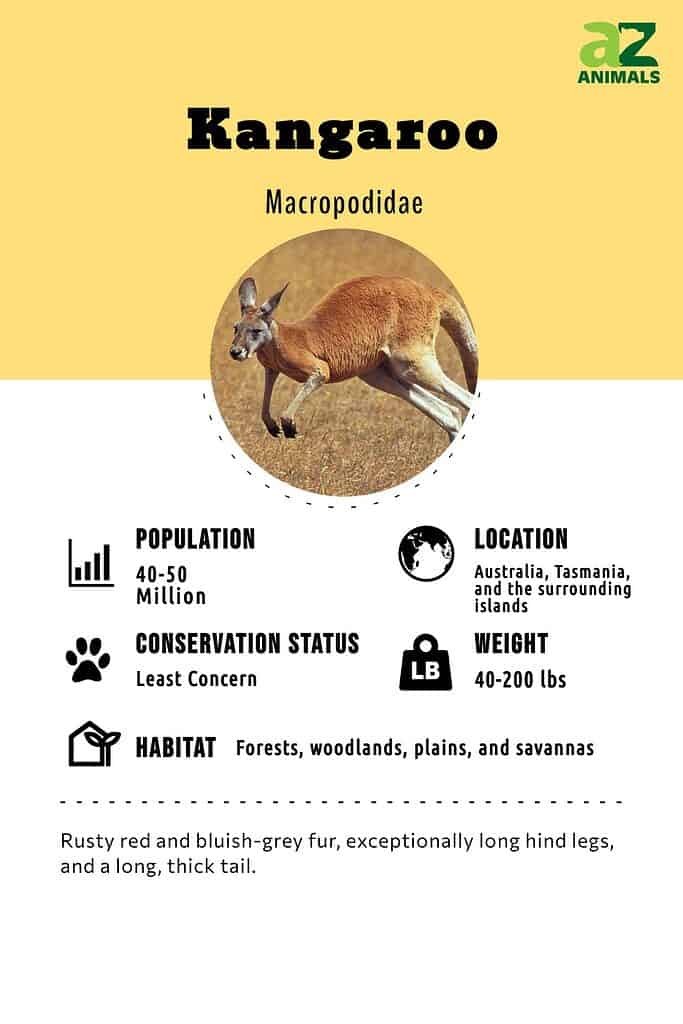
5 Incredible Kangaroo Facts!
- The name kangaroo was adapted into English from the aboriginal term ganguru. This was a Guugu Yimithirr word that specifically referred to the eastern grey kangaroo.
- Despite their important status in the Australian culture, these animals are still harvested for their skin and meat. These body parts are made into rugs, clothing, and even pet food.
- Like many grazing animals, the kangaroo breaks down vegetation via microbes in the gut. This fermentation process normally releases huge amounts of methane into the atmosphere when the animal burps, exhales, or farts. It’s actually believed that kangaroos produce less methane than other grazing animals, though how much less, and for what reason, is an open question.
- The evidence suggests that marsupials may have evolved the hopping ability some 20 million years ago, but it wasn’t until the expansion of grasslands across Australia some 3 to 5 million years ago that kangaroos really began to spread.
- A giant short-faced kangaroo, which weighed some 500 pounds, once prowled the continent. The facts suggest that it was too large to hop, but probably shuffled around on its two feet. They went extinct around the same time humans first arrived in Australia.

The kangaroo has adapted fairly well to the presence of humans.
©Andrea Izzotti/Shutterstock.com
Scientific Name
The kangaroo is formally defined as several large, hopping marsupials in the genus Macropus. This scientific name derives from the word macropod, which means “large foot” in Latin. The four main species in this classification are the red kangaroo, the western gray kangaroo, the eastern gray kangaroo, and the antilopine kangaroo. The black wallaroo and common wallaroo are also sometimes considered to be a true kangaroo as well. The wallaby is not considered to be a true kangaroo, but it’s similar enough to be a member of the same genus classification, Macropus. All of these species are part of the same family, which goes by the scientific name of Macropodidae.
Kangaroo vs. Wallaby
The difference between a kangaroo, a wallaroo, and a wallaby mostly comes down to size. Kangaroos are the largest members of the genus, while wallabies are the smallest. Wallaroos, as the name implies, have an intermediate size between the kangaroo and the wallaby. Otherwise, their anatomy is fairly similar.
Appearance
This animal’s most important anatomical feature is the exceptionally long hind legs. These legs are specifically adapted for bipedal hopping at distances up to 30 feet and a height of up to 10 feet. The animal has a unique arrangement of digits. Each hind foot consists of four individual toes, but only the big toe bears most of the animal’s weight. The second and third toes are actually fused together and highly reduced. The kangaroo’s hands have five digits and sharp claws. They are somewhat similar to human arms, but they lack opposable thumbs.
These animals also have a unique body shape to match its lifestyle. The body is defined by the big, arched back and a comparatively small head that ends in a sleek snout and big rounded ears. Another important feature is the long, thick tail, which serves as a kind of third leg to help it properly balance on the ground. The kangaroo’s coat color can vary between a rusty red and bluish-grey.
These animals take the crown as the world’s largest marsupial. Depending on the species, it stands about 3 to 7 feet tall and weighs 40 to 200 pounds. Females (also known as jills or does) are slightly smaller compared with males (which are called jacks or boomers). Females also have a forward-opening pouch with four teats.
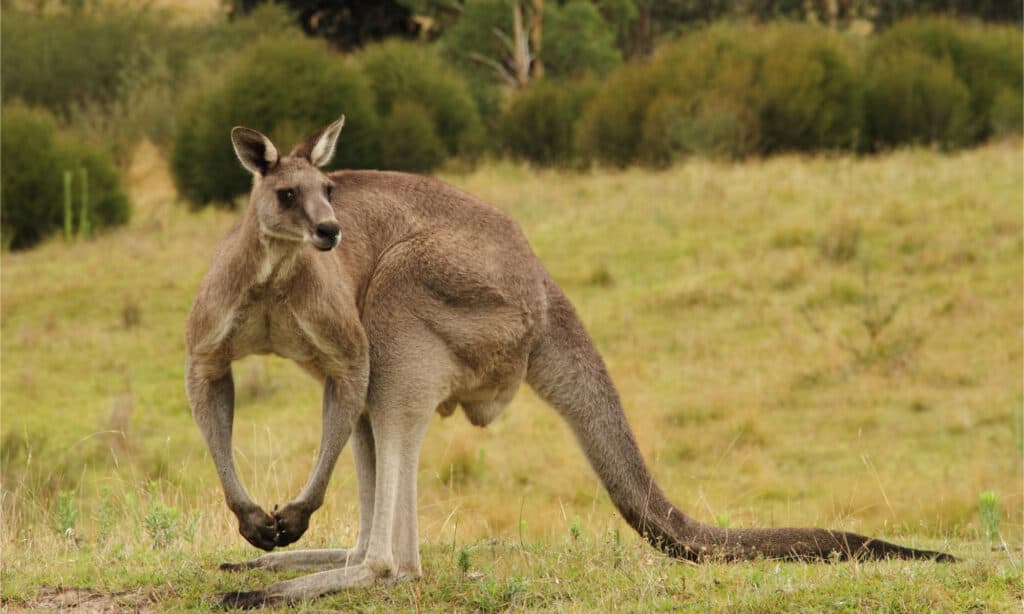
The kangaroo has a long, thick tail, and its coat color can vary between rusty red and bluish-grey.
©Katarina Christenson/Shutterstock.com
4 Types of Kangaroos
- Eastern Grey – The Eastern Grey Kangaroo is the second-largest kangaroo species, eastern greys are found in the eastern third of Australia and are quite abundant. There’s also a population on the island of Tasmania. The habitat range overlaps with the red kangaroo, but the two species are easy to differentiate, with the eastern grey sporting soft grey fur. Eastern grey kangaroos also prefer generally wetter climates than the red.
- Western Grey – The Western Grey Kangaroo lives along large portions of the southern coast of Australia from Perth to the border with Victoria. A small part of its range overlaps with the larger eastern grey kangaroo, but the two species never interbreed in the wild. They have a grey to brown coat, with paler shades around the chest, belly, and front of the neck. It is often difficult to tell them apart from the eastern grey, but the westerns generally have darker grey-brown fur and occasionally have a patch of black around the elbow.
- Red – The Red Kangaroo is the largest kangaroo species on earth and is the national animal of Australia. It can be found in most of the continent’s interior and along some of the northwestern coast. Compared to the eastern grey, the red prefers more arid climates with scrubland, grasses, and the occasional tree grove to shelter under. They are highly adaptive, adjusting well to human presence and sometimes eating into farmers’ fields.
- Antilopine – The Antilopine Kangaroo is the smallest kangaroo and is sometimes referred to as the Antilopine wallaroo. They live along the northern coast of Australia from the Cape York peninsula to the Kimberly region. Coloration varies but generally consists of an overall gray with a reddish-tan color covering the back and parts of the head. The underbelly is usually a cream color.
Evolution and History
The ancestors of the kangaroo diverted from other tree-dwelling marsupials and evolved into a ground-dwelling descendant between 3 to 15 million years ago. Marsupials have a distinctive pouch that helps mothers care for their young.
Somewhere along the timeline, they developed their signature hopping method of movement that makes them so remarkable today. Scientists are not sure exactly why this adaption happened, but hopping does appear to be an efficient form of locomotion.
As unusual as it sounds, Kangaroos have been able to adapt fairly well to the presence of humans and farming, while many of their cousin marsupials have not faired so well. They are also so prevalent that they are killed as game for their lean meat and also to reduce them as a pest population.
Behavior
The kangaroo is a highly social animal that likes to congregate in groups of between 10 and 100 individuals at a time, which are known as mobs, troops, or herds. The most common social arrangement involves a group of females, their offspring, and one or more males. However, since individuals can move around independently, these mobs only have a loose organization. The primary benefit is that groups offer protection and security for all of their members. An individual can signal the presence of danger by beating its tail against the ground.
These animals have numerous other ways to communicate with each other. These include eye contact, sniffing, touching, and vocalizations. They will seek to avoid confrontation when they can, but both males and females may fight each other for limited resources. The familiar boxing behavior for which they are known is a male-only competition to determine who gets access to females. These matches take a ritualized form in which one male issue a challenge and the other male can accept or decline. The males will lock arms, push each other, and kick out while standing on the tail.
The kangaroo is a very fast and agile animal that can achieve a top speed of about 40 mph and a consistent speed of around 20 to 25 mph. Because of its powerful leg muscles and big tail, the kangaroo actually expends less energy at this moderate cruising speed than at slower speeds. This allows it to outlast predators who may grow weary of the chase.
Kangaroos have the ability to feed at all hours of the day. However, they are most active at night or in other periods of low light. Most individuals stay within a well-defined home range and don’t move around too much except when they’re pursued.
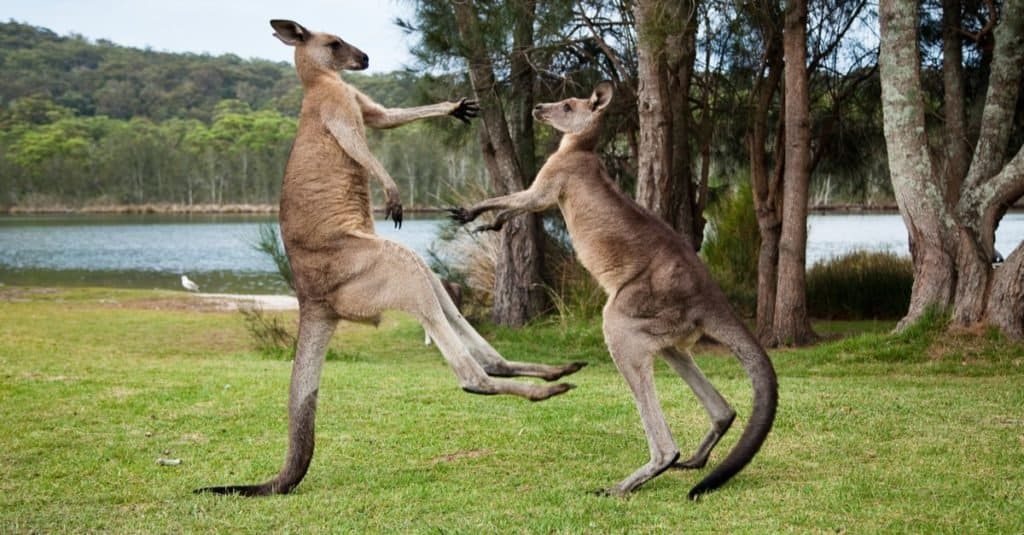
Kangaroo males will lock arms, push each other, and kick when fighting over females.
©Breathes/Shutterstock.com
Habitat
The kangaroo is found exclusively in Australia, Tasmania, and the surrounding islands. Each species has a different geographical range. The red kangaroo, which has the widest range, can be found all over the open plains of inland Australia. The eastern and western grey kangaroo species are found in the east and west, respectively. The antilopine kangaroo occupies the northern part of the country.
Kangaroos can live in a wide variety of different habitats, including grasslands, savannas, and bushlands with sparse woods or no trees at all. They are well-adapted for life in hot, dry conditions and can survive for long periods of time without water.
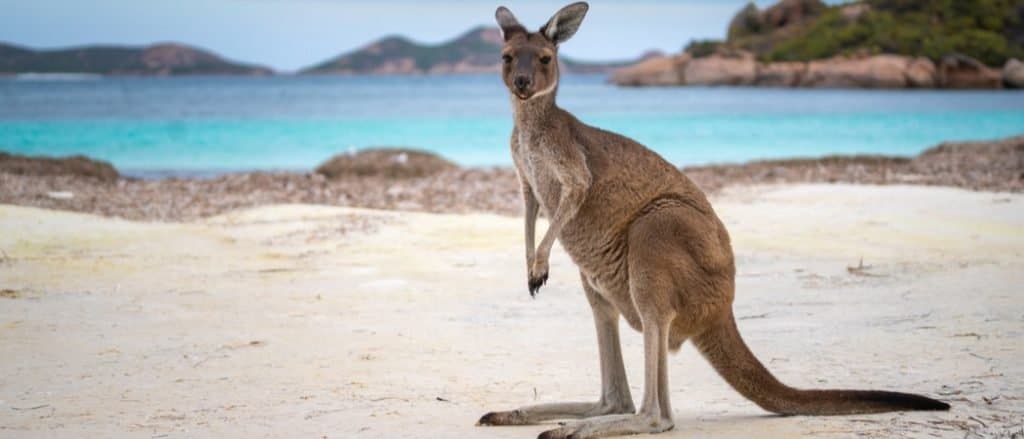
The kangaroo is native to Australia and Tasmania.
©anek.soowannaphoom/Shutterstock.com
Diet
The kangaroo has an herbivorous diet, which is reflected in its highly specialized anatomy. Like a cow, it has a multi-chambered stomach that allows it to digest tough plant material and draw out nutrients. The kangaroo also has the ability to regurgitate the food and chew it again to completely break down the material. The kangaroo’s sharp incisors are specialized for cutting vegetation close to the ground, while the flatter molars are specialized for grinding up the vegetation.
What does the kangaroo eat?
The kangaroo’s diet largely consists of grass, shrubs, and many different types of flowering plants.
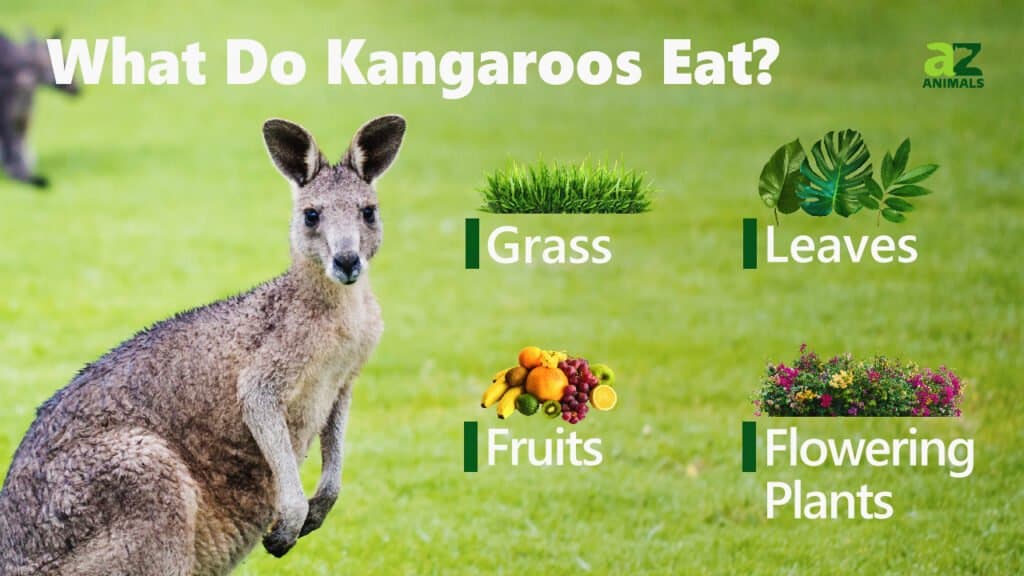
Predators and Threats
These animals are hunted by both people and other animals. They have been used as food and resources since people first arrived on the island some tens of thousands of years ago. Even today, many thousands of kangaroos are hunted and culled every year. Despite the large number of kangaroos killed, this has had minimal effect on their conservation status. In fact, like deer in the United States, kangaroo hunting is regulated and even encouraged as a way to control wild population numbers.
What eats the kangaroo?
A fully grown adult kangaroo has few natural predators in the wild. However, dingoes, feral cats, foxes, and raptors, many of which have been introduced by humans over the millennia, do sometimes feed on juveniles or dead kangaroos.
Reproduction, Babies, and Lifespan
The kangaroo is not limited to a single established breeding season. Instead, it can choose to mate at any time throughout the year as circumstances dictate. This means it is more likely to reproduce when resources are particularly bountiful. Kangaroos engage in a brief courtship period but do not form long-term pair bonds after copulation. Since reproduction is a bit of a free for all, males compete with each other to monopolize access to females. The male plays no other role in the development of the young.
After a month-long gestation period, the young joey is born hairless, helpless, and completely blind, measuring no more than an inch in size. The first thing it does is crawl into the mother’s pouch and attach it to her teat. It remains there for 120 to 400 days. Even after it emerges from the pouch, the young kangaroo will remain with its mother for another year and a half, growing to its adult size.
If resources are particularly plentiful, then the mother has the ability to take care of three offspring at the same time: the undeveloped embryo, the joey inside of the pouch, and a joey outside of the pouch. The embryo can enter a dormant state, known as diapause, for as long as necessary until the other baby has left the pouch. The mother’s anatomy is specifically adapted to deal with this. She has the ability to produce two different types of milk, one for the newborn joey and one for the larger juvenile. This allows her to maximize the number of offspring she can raise at one time. It may help the kangaroo recover quickly from long periods of drought, during which time reproduction is suspended to conserve resources for the mother.
If the joey’s development goes smoothly, then it can expect to reach sexual maturity within the first two years of age. The life expectancy of the typical kangaroo is around 20 years in the wild, though some individuals have been known to live longer.
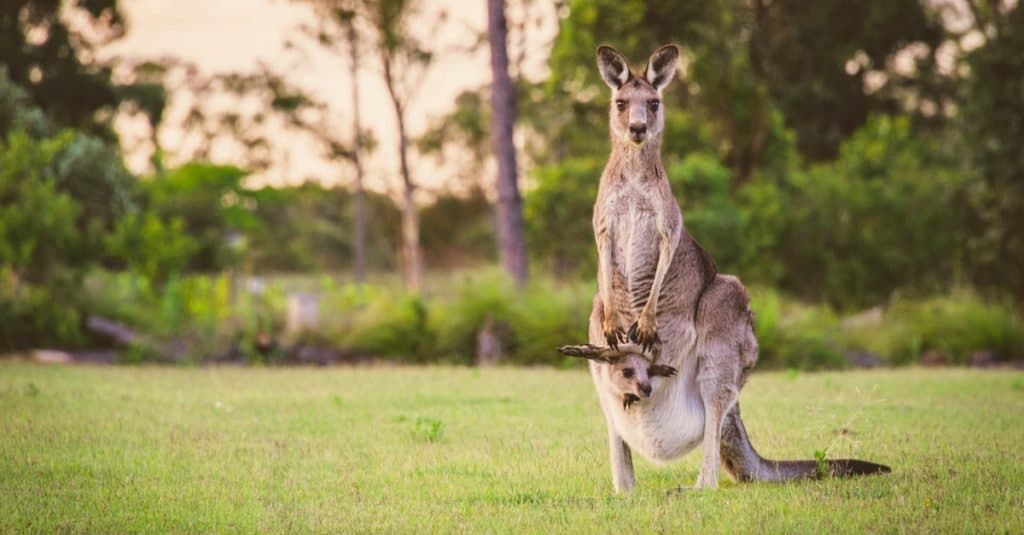
If a joey is still in the pouch of a pregnant kangaroo, the younger sibling can enter a dormant state called embryonic diapause.
©IntoTheWorld/Shutterstock.com
Population
According to the IUCN Red List, the current classification of the four kangaroo species, plus the common wallaroo, is least concern. Only the black wallaroo is considered to be near threatened. The best population estimates suggest that tens of millions of kangaroos roam across Australia.
In the Zoo
The San Diego Zoo is one of the major destinations in the United States for both red and gray kangaroos and several wallaby species. Their Walkabout Australia section, which opened at the Safari Park in 2018, allows visitors to walk along the pathways among the grassy habitat and get an up-close view of the animals. Other major destinations include the Denver Zoo, Saint Louis Zoo, Detroit Zoo, Cincinnati Zoo and Botanical Garden, Philadelphia Zoo, Dallas Zoo, San Francisco Zoo, Columbus Zoo and Aquarium, and much more.
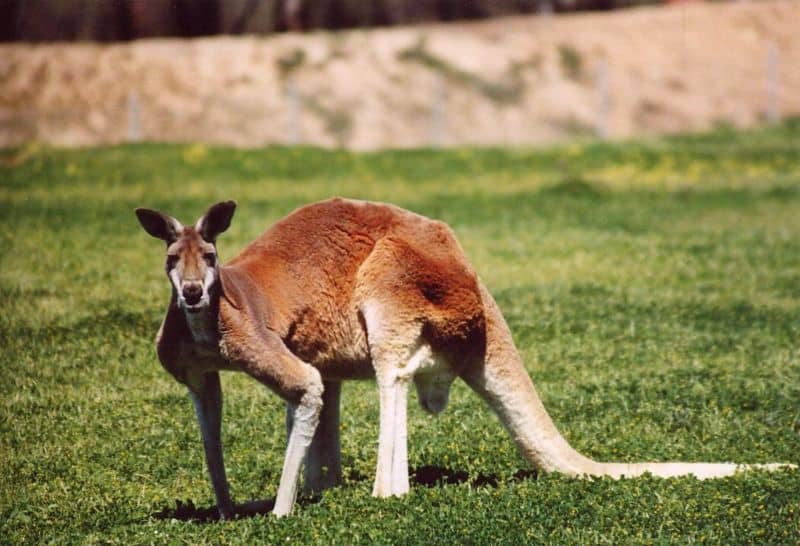
There are many zoos across the United States that have kangaroos, and the San Diego Zoo has a special trail that brings visitors very close to kangaroos!
©Rileypie – Public Domain
Kangaroo FAQs (Frequently Asked Questions)
Are Kangaroos herbivores, carnivores, or omnivores?
Kangaroos are Omnivores, meaning they eat both plants and other animals.
What Kingdom do Kangaroos belong to?
Kangaroos belong to the Kingdom Animalia.
What class do Kangaroos belong to?
Kangaroos belong to the class Mammalia.
What phylum to Kangaroos belong to?
Kangaroos belong to the phylum Chordata.
What family do Kangaroos belong to?
Kangaroos belong to the family Macropodidae.
What order do Kangaroos belong to?
Kangaroos belong to the order Diprotodontia.
What type of covering do Kangaroos have?
Kangaroos are covered in fur.
In what type of habitat do Kangaroos live?
Kangaroos live in dry forests, deserts, and grasslands.
What is the main prey for Kangaroos?
Kangaroos eat grass, seeds, and flowers.
What are some predators of Kangaroos?
Predators of Kangaroos include humans and dingos.
How many babies do Kangaroos have?
The average number of babies a Kangaroo has is 2.
What is an interesting fact about Kangaroos?
Female Kangaroos have a deep pouch on their front!
What is the lifespan of a Kangaroo?
Kangaroos can live for 4 to 10 years.
How fast is a Kangaroo?
A Kangaroo can travel at speeds of up to 35 miles per hour.
Are kangaroos friendly?
Kangaroos are shy and withdrawn by nature. They will rarely attack humans without being provoked first. However, they are best avoided, since if they do attack, their kicks can do serious harm to a person. Only an experienced kangaroo expert should attempt to make friends with this animal.
Is a kangaroo and a wallaby the same?
Kangaroos and wallabies are anatomically similar. The main difference is the wallaby’s much smaller size.
What is a baby kangaroo called?
A baby kangaroo is called a joey.
How high can a kangaroo jump?
One of the most remarkable facts about the kangaroo is that it can jump up to 10 feet high.
What does kangaroo taste like?
Kangaroo meat is supposed to taste a little like beef. The meat is almost always sourced from wild animals that are hunted as a means of population control. When one species starts over-breeding, licensed hunters are allowed to cull the extra population.
Who would win in a fight between a human and a kangaroo?
A kangaroo would win a fight against a human being.
Who would win in a fight between a gorilla and a kangaroo?
A gorilla would win a fight against a kangaroo.
Thank you for reading! Have some feedback for us? Contact the AZ Animals editorial team.
Sources
- San Diego Zoo / Accessed February 28, 2021
- Britannica / Accessed February 28, 2021


















